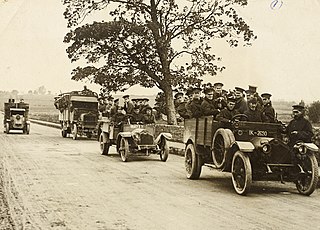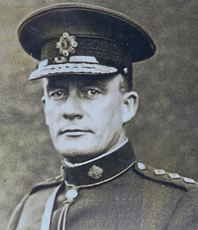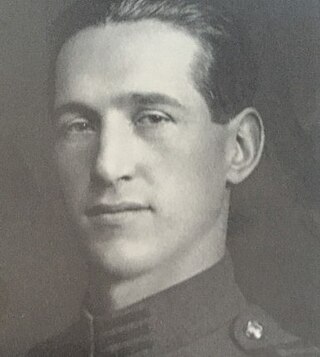Related Research Articles

The Irish Republican Army was an Irish republican revolutionary paramilitary organisation. The ancestor of many groups also known as the Irish Republican Army, and distinguished from them as the "Old IRA", it was descended from the Irish Volunteers, an organisation established on 25 November 1913 that staged the Easter Rising in April 1916. In 1919, the Irish Republic that had been proclaimed during the Easter Rising was formally established by an elected assembly, and the Irish Volunteers were recognised by Dáil Éireann as its legitimate army. Thereafter, the IRA waged a guerrilla campaign against the British occupation of Ireland in the 1919–1921 Irish War of Independence.

The Irish War of Independence or Anglo-Irish War was a guerrilla war fought in Ireland from 1919 to 1921 between the Irish Republican Army and British forces: the British Army, along with the quasi-military Royal Irish Constabulary (RIC) and its paramilitary forces the Auxiliaries and Ulster Special Constabulary (USC). It was part of the Irish revolutionary period.

Bloody Sunday was a day of violence in Dublin on 21 November 1920, during the Irish War of Independence. More than 30 people were killed or fatally wounded.

The Royal Irish Constabulary was the police force in Ireland from 1822 until 1922, when all of the country was part of the United Kingdom. A separate civic police force, the unarmed Dublin Metropolitan Police (DMP), patrolled the capital and parts of County Wicklow, while the cities of Derry and Belfast, originally with their own police forces, later had special divisions within the RIC. For most of its history, the ethnic and religious makeup of the RIC broadly matched that of the Irish population, although Anglo-Irish Protestants were overrepresented among its senior officers.

The Dublin Metropolitan Police (DMP) was the police force of Dublin in British-controlled Ireland from 1836 to 1922 and then the Irish Free State until 1925, when it was absorbed into the new state's Garda Síochána.

The Irish National Invincibles, usually known as the Invincibles, were a militant organisation based in Ireland active from 1881 to 1883. Founded as splinter group of the Irish Republican Brotherhood, the group had a more radical agenda, and was formed with an intent to target those who implemented English policies in Ireland.
The Cairo Gang was a group of British military intelligence agents who were sent to Dublin during the Irish War of Independence to identify prominent members of the Irish Republican Army (IRA) with, according to information gathered by the IRA Intelligence Department (IRAID), the intention of disrupting the IRA by assassination. Originally commanded by British Army General Gerald Boyd, they were known officially as the Dublin District Special Branch (DDSB) and also as D Branch.
The Squad, nicknamed the Twelve Apostles, was an Irish Republican Army (IRA) unit founded by Michael Collins to counter British intelligence efforts during the Irish War of Independence, mainly by means of assassination. The Squad engaged in executing informants, police active in harassment of IRA personnel, enemy agents and worked in counterespionage.
The Dublin Guard was a unit of the Irish Republican Army during the Irish War of Independence and then of the Irish National Army in the ensuing Civil War.

This is a timeline of the Irish War of Independence of 1919–21. The Irish War of Independence was a guerrilla conflict and most of the fighting was conducted on a small scale by the standards of conventional warfare.

Eamon "Ned" Broy was successively a member of the Dublin Metropolitan Police, the Irish Republican Army, the National Army, and the Garda Síochána of the Irish Free State. He served as Commissioner of the Gardaí from February 1933 to June 1938. He later served as president of the Olympic Council of Ireland for fifteen years.

David Neligan, known by his soubriquet "The Spy in the Castle", was a crucial figure involved in the Irish War of Independence (1919–21) and subsequently became Director of Intelligence for the Irish Army after the Irish Civil War (1922–23).

Seán Allis Treacy was one of the leaders of the Third Tipperary Brigade of the IRA during the Irish War of Independence and one of a small group whose actions initiated that conflict in 1919. He was killed in October 1920, on Talbot Street in Dublin in a shootout with British troops during an aborted British Secret Service surveillance operation.
Detective Sergeant Denis O'Brien, sometimes called "Dinny O’Brien", was a veteran of the Irish War of Independence and the Irish Civil War. He joined the Garda Síochána in 1933 and was killed by the Anti-Treaty IRA in 1942.
The Criminal Investigation Department (CID) in the Irish Free State was an armed, plain-clothed counter-insurgency police unit that operated during the Irish Civil War. It was organised separately from the unarmed Civic Guard police force. The unit was formed shortly after the truce with the British and disbanded in October 1923.
Eamonn Coogan was an Irish Fine Gael politician, barrister and Deputy Commissioner of the Garda Síochána.
Vincent Patrick Fovargue was a company officer in the Dublin brigade of the IRA during the Irish War of Independence, who was shot dead in England by the IRA, which accused him of being a British spy.
Colonel Thomas Gay was the handler of a large spy ring working on behalf of Michael Collins during the Irish War of Independence. A commercial clerk by trade he later became an assistant and then subsequently head librarian with Dublin Corporation where he spent most of his career. An early member of the Irish Volunteers and an enthusiast for Gaelic Games he developed a network of important intelligence contacts which he put at the disposal of Michael Collins. As such, he played a critical role in the success of that network.
The Drumcondra ambush was an attempted ambush carried out the Irish Republican Army (IRA) in Drumcondra, a suburb in northern Dublin, during the Irish War of Independence. On 21 January 1921, an IRA active service unit (ASU) initially set up an ambush near the Royal Canal in preparation for a British lorry which was travelling through the area. When the lorry failed to arrive, Frank Flood, the unit's commander, relocated his men up to a new position along the Tolka river. However, the IRA unit was spotted as they were setting up their new positions and a force of Auxiliaries was sent out, which resulted in 1 volunteer being killed and 5 others being arrested as they were attempting to escape.
References
- 1 2 3 Patrick Maume, ‘Mallon, John (1839–1915)’, Oxford Dictionary of National Biography, Oxford University Press, 2004
- ↑ Dukova, Anastasia (2016). A History of the Dublin Metropolitan Police and its Colonial Legacy (1 ed.). UK: Palgrave Macmillan. p. 59. ISBN 978-1-137-55582-3 . Retrieved 21 February 2020.
- ↑ Dukova, Anastasia (2016). A History of the Dublin Metropolitan Police and its Colonial Legacy (1 ed.). UK: Palgrave Macmillan. p. 59. ISBN 978-1-137-55582-3 . Retrieved 21 February 2020.
- ↑ Neligan, David (1968), The Spy in the Castle, MacGibbon & Kee, London, pg 172, SBN 261.62060.6
- ↑ Christy Campbell, p.58-9
- ↑ Cottrell, Peter (2006). The Anglo-Irish War: The Troubles of 1913-1922. Osprey Publishing. p. 66. ISBN 1846030234.
- ↑ The Irish War: The Hidden Conflict between the IRA and British Intelligence by Tony Geraghty ( ISBN 978-0801871177), p.336
- ↑ Cottrell, op. cit., p.53.
- ↑ Shooting 'The Dog' by Sean Ryan in History Ireland (Vol 27-n°4) pp 40-41 - July–August 2019
- ↑ Mackay, James. Michael Collins: A Life
- ↑ "Kavanagh Family". Archived from the original on 27 June 2022. Retrieved 16 April 2012.
- ↑ New York Times, 16 April 1920
Bibliography
- Abbotts, Richard, Police Casualties in Ireland 1914-1918 (Cork 2000)
- Brewer, John D., The Royal Irish Constabulary: An Oral History (Belfast 1990)
- Dukova, A. A History of the Dublin Metropolitan Police and Its Colonial Legacy (Palgrave Macmillan 2016)
- Gaughan, J.A.(ed.), The Memoirs of Constable Jeremiah Mee RIC (Dublin 1973)
- Herlihy, Jim, The Royal Irish Contabulary (Dublin 1997)